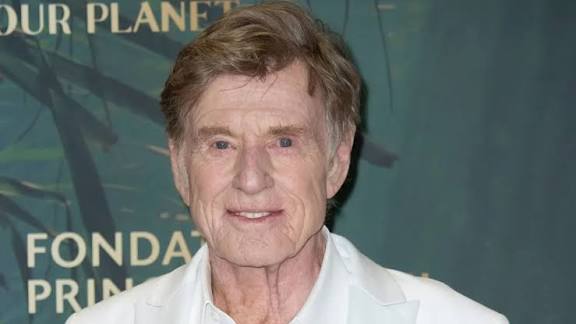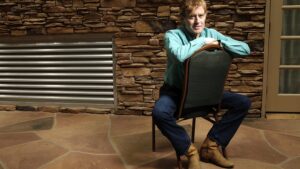Redford’s Final Line: World’s Waiting, Make a Move

Redford sees her and says, “George, the whole world is waiting. Make a trick.” Today we will discuss about Redford’s Final Line: World’s Waiting, Make a Move
Redford’s Final Line: World’s Waiting, Make a Move
Robert Redford, acting legend, director, activist, and co-founder of Sundance, passed away on September 16, 2025, at the age of 89. In his final on-screen appearance, he offered more than one last performance: he delivered a line that seemed to carry his characteristic fusion of gravitas, wit, and gentle challenge. “George, the whole world is waiting. Make a move.”
At first glance, it’s just a clever ad-lib in a short cameo in AMC’s Dark Winds. Underneath, it’s a loaded moment: a salute to artistry, a nudge at time, a commentary on legacy, and maybe, just maybe, Redford reminding us all—writers, actors, audiences—that waiting is its own kind of pressure.
In this article, we trace the context of that line, its meaning, the relationships around it, and what it reveals about Redford’s values and his final act in front of a camera.
I. The Setting: “Dark Winds,” Chess, Camera, Cameo

A. What Dark Winds Is
Dark Winds is an AMC/AMC+ series based on Tony Hillerman’s Leaphorn & Chee detective novels, set in the American Southwest during the 1970s, involving Navajo Tribal Police. The show has earned praise for its atmosphere, cultural authenticity, and narrative tension. Redford had been involved behind the scenes: he was an executive producer on the show.
B. The Cameo
Redford appeared in the season 3 premiere (episode “Ye’iitsoh (Big Monster)”) in a brief scene shared with George R.R. Martin, also an executive producer of Dark Winds. In that scene, both men portray inmates who are playing chess inside a cell. It’s a small, quiet moment in the larger narrative, but one imbued with resonance—because of the actors, of course, but also because of what is said.
C. The Line and the Setup
The script originally had no dialogue for that moment. But Redford ad-libbed. As he looked at Martin’s character about to move a chess piece, he said: “George, the whole world is waiting. Make a move.”
Then another character, Lieutenant Joe Leaphorn (played by Zahn McClarnon), gives Martin advice on the chess move. Martin makes it, winning the game. And Redford’s final utterance on screen: “Thanks a lot.”
These two lines form the closing of Redford’s acting legacy. The first: the challenge. The second: the surrender, or humorous acceptance. A moment of comedic humility after the tug of competition.
II. Layers of Meaning: Humor, Tribute, and the Unsaid
A. The Surface: Chess, Waiting, Making a Move
Chess is metaphor: patience, strategy, risk. In that cell, the two men waiting, weighing moves. To “make a move” in chess is literal. But when Redford says, “The whole world is waiting, make a move,” it opens up layers: what move? In life, creativity, art. A suggestion that standing still has consequences—even when physical movement seems constrained.
B. The George R.R. Martin Angle
George R.R. Martin is famously working on The Winds of Winter, the much-anticipated next installment in A Song of Ice and Fire. Fans have waited years. Redford’s ad-lib line plays as both a gentle tease and a nod to that public expectation.
That aspect—the “world waiting”—takes on dual meaning: the characters in the scene, sure; but also real life. The world waiting for the next book, waiting for stories, waiting for art. Redford’s line, then, becomes a kind of meta-observation about creative work and the expectations around it.
C. Redford’s Own Legacy and Timing
Redford was 89 when he died. He hadn’t been in front of the camera often in recent years; his last film appearance before this was Avengers: Endgame in 2019. 1 By choosing this cameo, in a small but meaningful role, he reclaimed some of that presence. And by ad-libbing a line about waiting and making a move, he maybe was reflecting on what it means to pause, to act, to leave behind something.
His request for a closed set during filming shows his professionalism and care for how this scene would be remembered.
D. On Waiting, On Art, On the Universe
Redford’s line also echoes a universal experience: waiting. We wait for someone to speak, someone to change, someone to begin. Waiting is implicit in many human stories: creative block, moral courage, change, the passage of time. Redford’s body of work, his activism, his attention to truth and beauty, suggests he believed that the moment of waiting is not inert—it has its own tension. And to “make a move” is to accept risk, to act, to step forward even when the outcome is uncertain.
III. How This Moment Resonates
A. With Fans of George R.R. Martin / A Song of Ice and Fire
Given the huge anticipation around The Winds of Winter, this line reignited conversations, jokes, memes, hopeful theories. For many fans, Redford’s line felt like both ribbing and support: “Yes, we are all waiting, but maybe this is the push.” It’s rare when a cameo lands not only in narrative context, but in broader pop cultural conversation. Redford pulled that off.
B. With Film/TV Industry
For actors who have long careers, the question of “What will your final work be?” often looms. Will it be small? Will it be grand? Will it reflect your beliefs? Redford’s final on-screen act was modest in scale, but rich in meaning. It speaks to the power of choice: to cameo rather than headline; to speak fewer words rather than more; to leave people with something to think.
Also, it demonstrates that even in an era of spectacle, subtlety and personal voice still matter. Redford, who helped shape independent film through Sundance, left with a whisper rather than a roar—but one that still echoes.
C. With Redford himself, and His Values
Redford’s life was not just about performances. He was committed to the environment, activism, Native American rights, artistic integrity. His investment in Dark Winds as a series that tells indigenous stories well was more than business; it was part of his life’s work.
That he would choose his final scene in a show like this, in a moment of contest and anticipation, is consistent with that path. It’s not flashy; it’s meaningful.
IV. The Final Words: More Than a Goodbye
The very last line Redford says on screen, “Thanks a lot,” to the character who helped Martin win, carries its own weight. It implies gratitude, perhaps acceptance, perhaps wry humor at being outmaneuvered. It’s a softer counterpart to the first line: from urging action to acknowledging it, even when you’re on the losing side of the move.
Because final words in art are often over-interpreted, this one fits: warm, human, somewhat self-deprecating. It feels like Redford at peace with both the loss in the chess game and the bigger sense of finality. It’s appropriate for someone whose career spanned so many roles, many wins, many losses, many changes, and always a desire to see forward.
V. What It Teaches Us: Waiting, Moves, Legacy
What could we, as audience, as artists, as people living with waiting, learn from this?
-
That even a small moment can say much. A short cameo, a few lines, delivered thoughtfully, can carry enormous emotional, thematic, cultural weight.
-
Waiting is not empty. The tension of waiting—whether for that great novel, for social change, or our own life’s next step—is full of potential. And sometimes, all that’s needed is a move.
-
Humor is brave. To tease George R.R. Martin about finishing the next book is gentle, but comes from a place of affection, not cruelty. To speak truth to expectations with a smile is powerful.
-
Legacy is a living thing. Redford didn’t simply rest on his past. He kept contributing; he made choices; he invested in new stories. Legacy isn’t static—it’s how you show up at the end too.
VI. Counterpoints & Reflections
-
Some might say: it’s just a joke. A cameo. Overanalyzing a few words. Maybe so. But art’s meaning is often in what people bring to it.
-
Others might argue: is it fair to put pressure on Martin? But the tone is gentle, affectionate. Even if it raises an eyebrow, it doesn’t demand—it reminds.
-
Also, in considering “final lines” of any artist, there is risk of reading too much into finality. But Redford himself seemed comfortable with his stage in life; he wasn’t scrambling, he was choosing. The context supports reading it as more than coincidence.
VII. Redford’s Place in the Pantheon, and What This Adds
Robert Redford was part of a generation that bridged the classic Hollywood, the New Wave, independent film, environmental and social activism in the arts. His footprints are everywhere: in Butch Cassidy and Sundance Kid, The Sting, All the President’s Men, Ordinary People, founding Sundance, promoting indie film, giving voice to under-represented stories.
His final act on screen echoes many of his earlier priorities: collaboration, sense of story, humility, attention to culture, and a belief that the world is waiting—for truth, for art, for action.
In some ways, Redford’s final line becomes an appropriate capstone: urging action when most expect rest. Encouraging movement when many would accept pause. Suggesting that even at the end, one more move matters.
VIII. Conclusion: Make a Move
“George, the whole world is waiting. Make a move.” It’s not just a line in a final cameo. It’s almost a mission statement, a farewell, a legacy. Robert Redford passed away days after this moment’s public recognition, but the words linger. They ask us: what are we waiting for? When will we act? What stories remain unfinished? Which creative move have we paused too long on?
Redford’s final screen performance, then, is less about ending and more about urging continuation. For writers, actors, activists, and audiences: life is less about the last word than the next move.
And in that, Redford stays with us—not as someone who is gone, but someone who still, through that last whisper, demands we move.
How useful was this post?
Click on a star to rate it!
Average rating 0 / 5. Vote count: 0
No votes so far! Be the first to rate this post.
About the Author
usa5911.com
Administrator
Hi, I’m Gurdeep Singh, a professional content writer from India with over 3 years of experience in the field. I specialize in covering U.S. politics, delivering timely and engaging content tailored specifically for an American audience. Along with my dedicated team, we track and report on all the latest political trends, news, and in-depth analysis shaping the United States today. Our goal is to provide clear, factual, and compelling content that keeps readers informed and engaged with the ever-changing political landscape.




